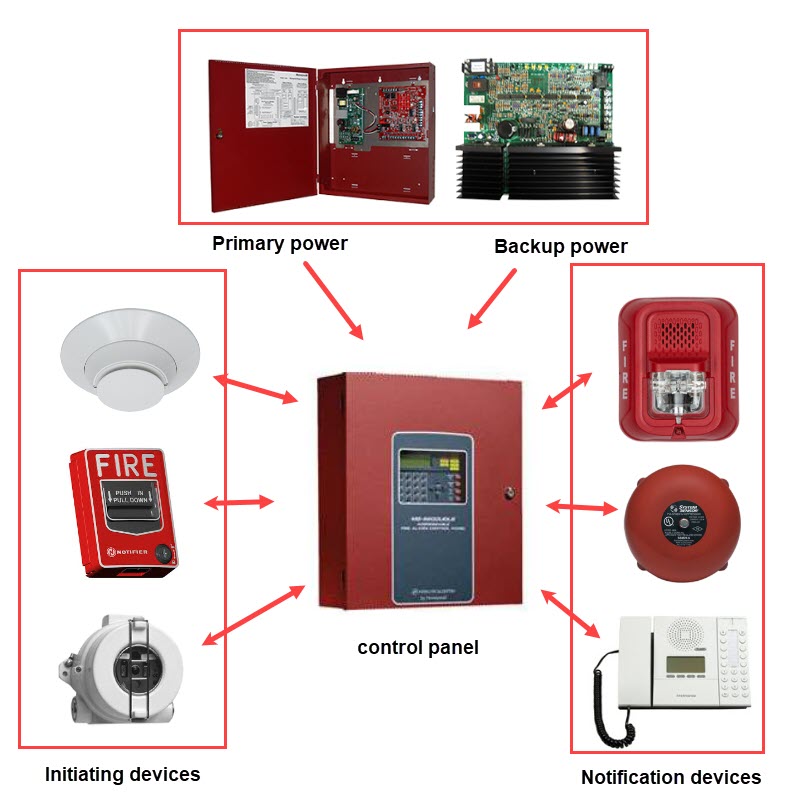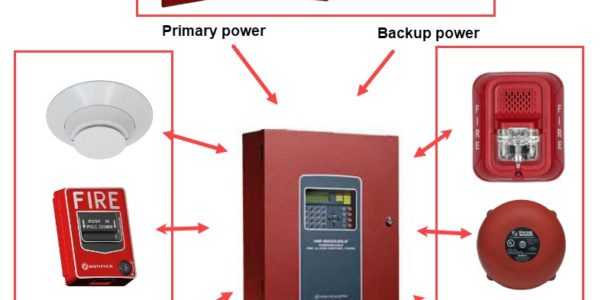
The Five Basic Parts of a Fire Alarm System
Commercial and industrial fire alarm and life safety systems consist of five basic parts that make up a complete fire alarm system and include the following:
- Fire alarm control panel
- Initiating devices
- Notification devices
- Primary power supply
- Backup power supply
Fire Alarm Control Panel (FACP)
The fire alarm control panel is the brains of the whole operation, the system hub that monitors system integrity, inputs, outputs and relays all information. When an initiating device is triggered, it sends a signal to the fire alarm control panel, which then triggers the notification devices or the alarm. Conventional fire alarm control panels might contain standard branch circuit wiring with replaceable circuit cards, with one for each designated zone. More advanced systems might contain digital circuits to transmit data to all devices that can be programmed for zones. All FACPs will display the status of your system with troubleshooting codes that may allow you to make manual adjustments like disabling an alarm or resetting the system after an issue. Always check with your fire alarm system provider with any questions on status alerts.
Initiating Devices
Initiating devices activate the system in an emergency situation and can be either manual or automatic.
Manual – a manual pull station is an example of a manual initiating device that requires someone to actually pull the lever, push a button or break glass to manually initiate the alarm.
Automatic – automatic initiation devices include detection devices for smoke, gas, flame, and heat. Initiation devices can be either addressable or not addressable, with addressable devices signaling the exact location of the emergency. There are different types of smoke detectors like air aspirating detectors or beam detectors which is different technology to detect smoke but send a signal to the control panel to signal an alarm just the same.
Your fire alarm system provider can help you determine which type of initiation devices are best for your building and exactly where they should be located for maximum safety and code compliance.
Notification Devices
Notification devices notify all occupants of a building when a fire or emergency situation exists. They include strobe lights, horns, sirens, bells, or combination strobe and horns. They may also include audible notification such as specific instructions on how to safely evacuate a building. Mass notification systems can be programmed to deliver different messages for different events or custom audible alerts.
Primary Power Supply
The primary power supply for fire alarm system is typically either on a 120- or 240- Volt AC power source supplied by your power company.
Backup Power Supply
A backup power supply is an important part of fire alarm systems as your fire and life safety system must still operate in the event of a power outage. Your backup power supply is powered by 6- or 12- Volt batteries to keep your system operational if a power failure occurs.
These are the five most basic parts of a commercial fire alarm system. High-Rise Security Systems is a leading fire and life safety system provider in the Chicago, IL area offering comprehensive commercial fire alarm system services. We help contractors and building owners to determine the best type of commercial fire alarm system for your property and business activities.
HRSS/SMG offers complete system design and CAD drawings for proper placement of all initiating and notification devices. We provide UL listed equipment, fire alarm system maintenance, testing, inspection, and monitoring 24/7/365. Contact us to learn more about commercial fire alarm system solutions and ensuring that all of your basic system components are working together for maximum safety.



